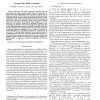Free Online Productivity Tools
i2Speak
i2Symbol
i2OCR
iTex2Img
iWeb2Print
iWeb2Shot
i2Type
iPdf2Split
iPdf2Merge
i2Bopomofo
i2Arabic
i2Style
i2Image
i2PDF
iLatex2Rtf
Sci2ools
TMM
2002
2002
Foveated video quality assessment
Most image and video compression algorithms that have been proposed to improve picture quality relative to compression efficiency have either been designed based on objective criteria such as signal-to-noise-ratio (SNR) or have been evaluated, post-design, against competing methods using an objective sample measure. However, existing quantitative design criteria and numerical measurements of image and video quality both fail to adequately capture those attributes deemed important by the human visual system, except, perhaps, at very low error rates. We present a framework for assessing the quality of and determining the efficiency of foveated and compressed images and video streams. Image foveation is a process of nonuniform sampling that accords with the acquisition of visual information at the human retina. Foveated image/video compression algorithms seek to exploit this reduction of sensed information by nonuniformly reducing the resolution of the visual data. We develop unique algor...
Image | Objective Sample Measure | TMM 2002 | Video |
| Added | 23 Dec 2010 |
| Updated | 23 Dec 2010 |
| Type | Journal |
| Year | 2002 |
| Where | TMM |
| Authors | Sanghoon Lee, Marios S. Pattichis, Alan C. Bovik |
Comments (0)

